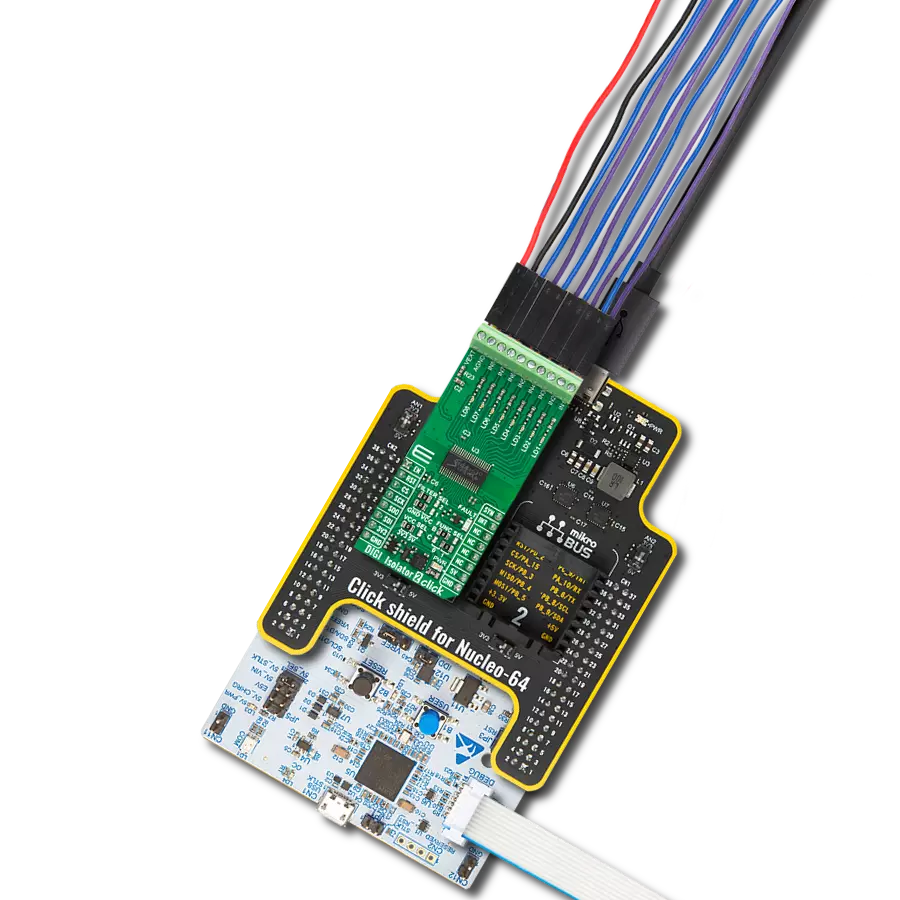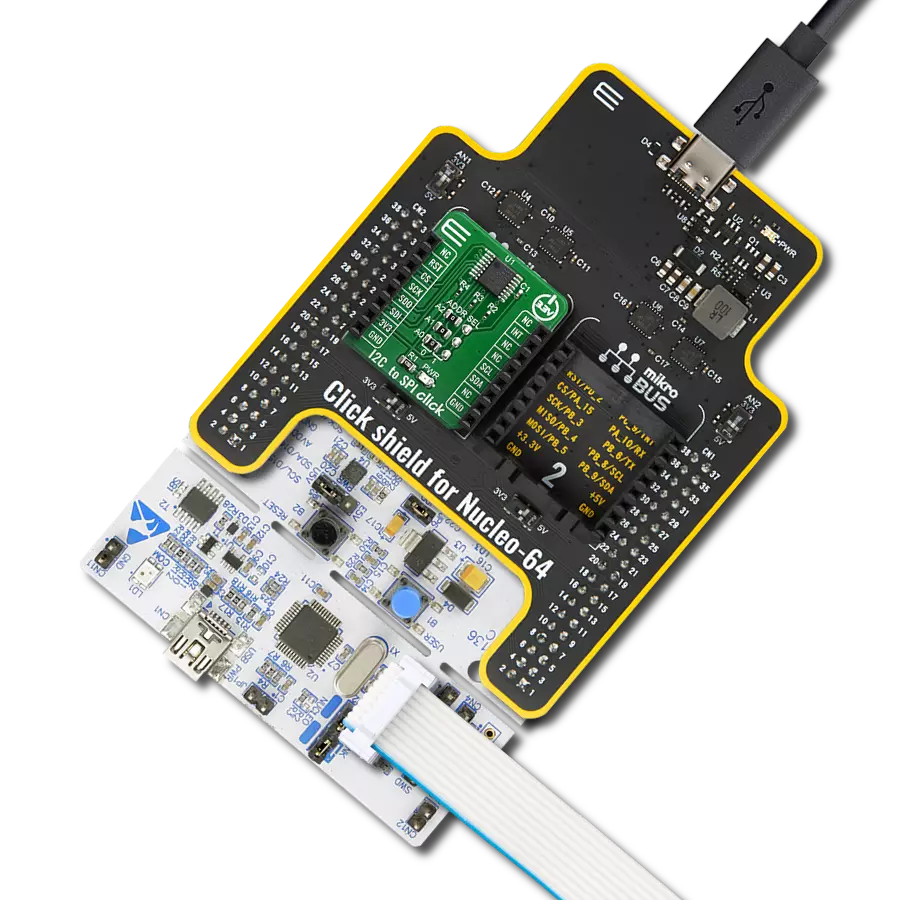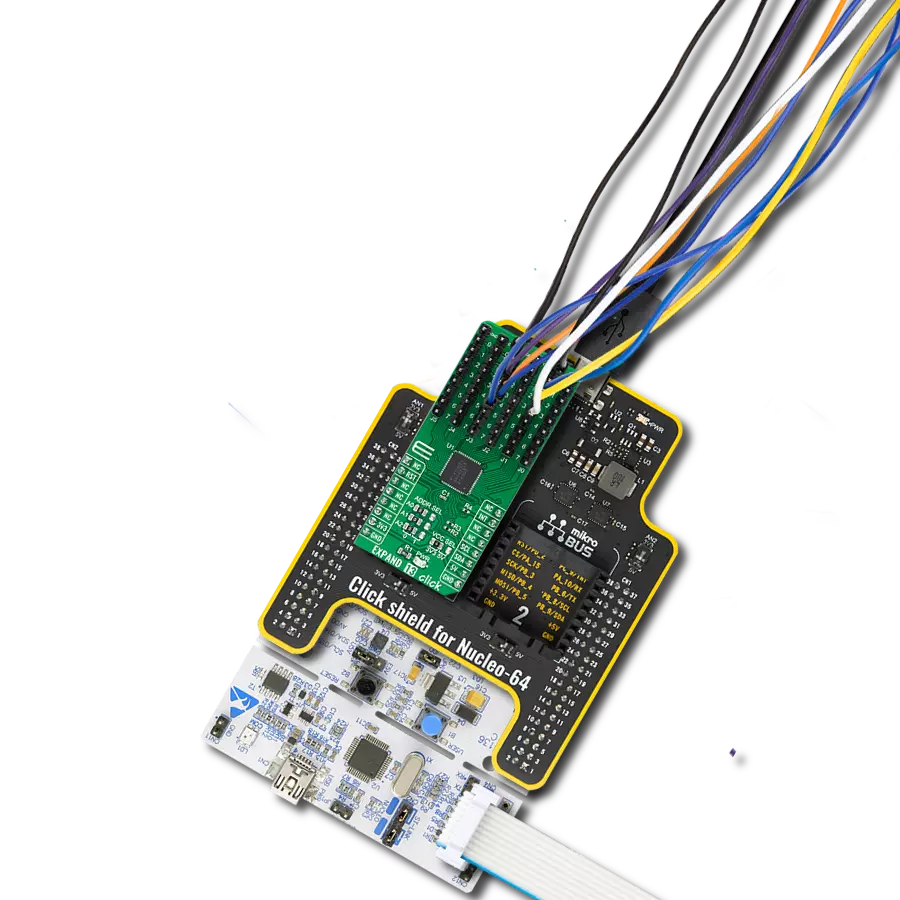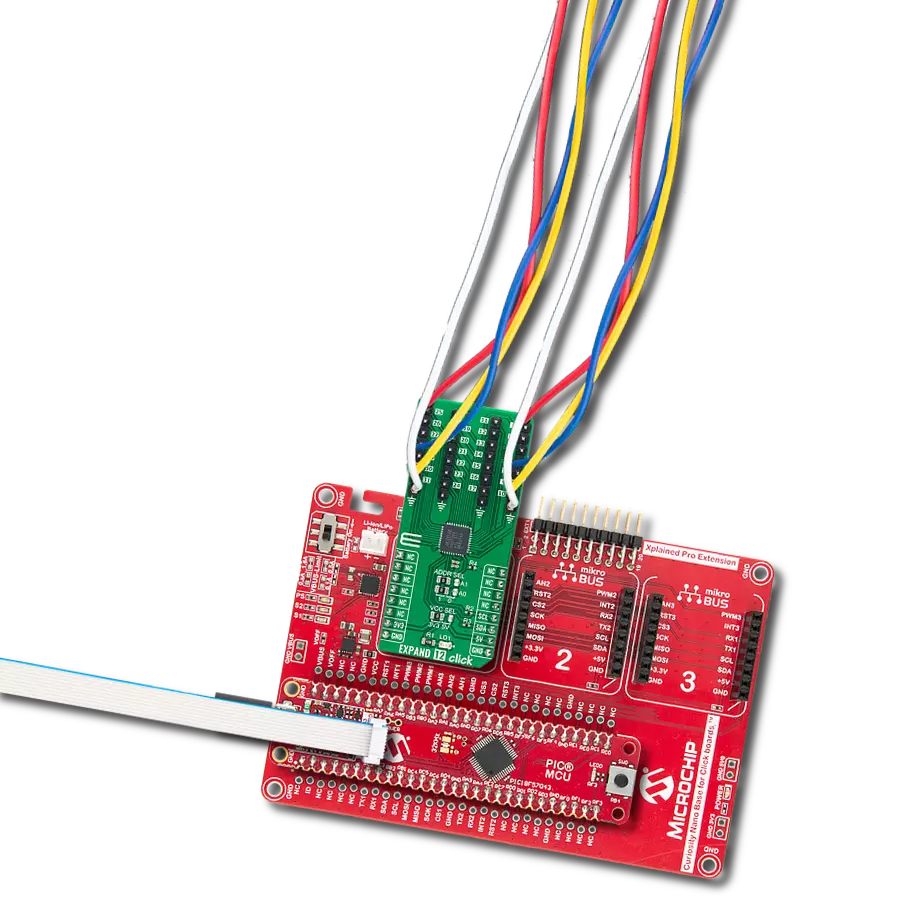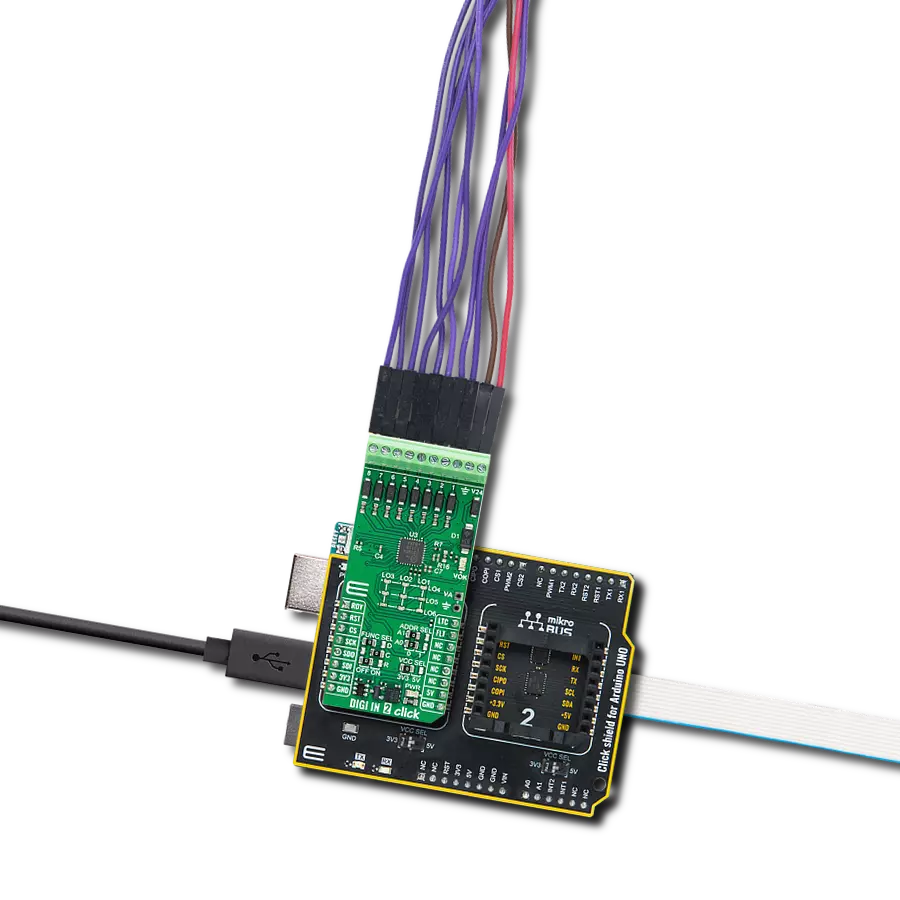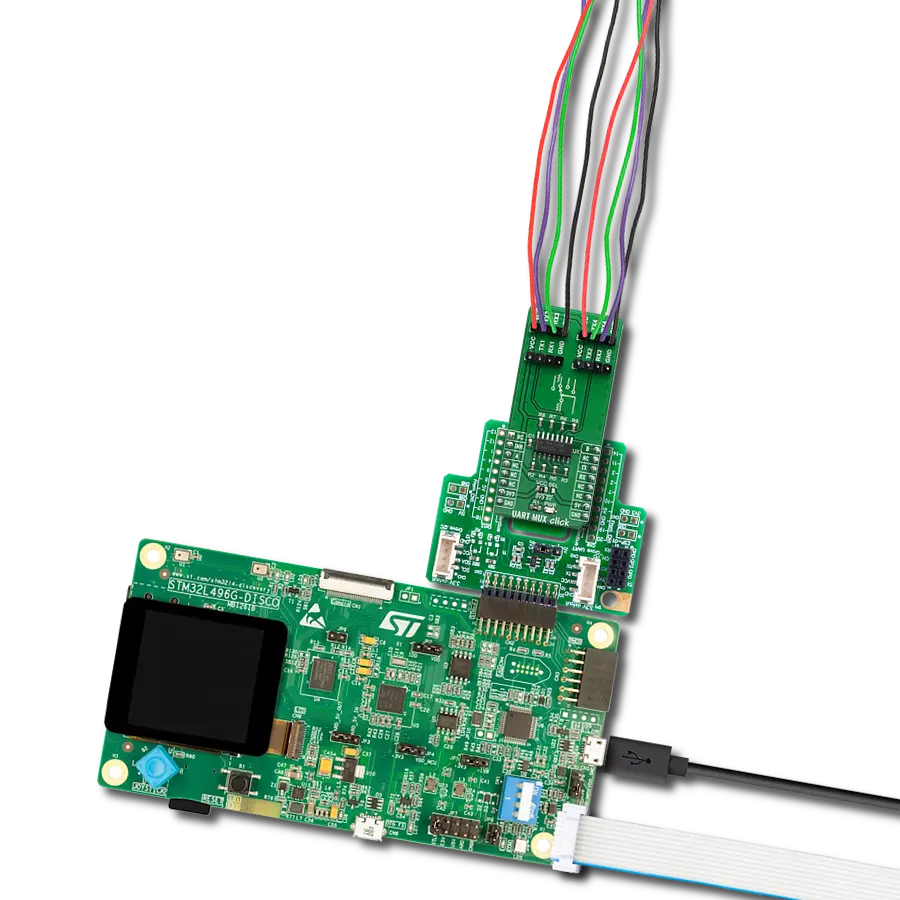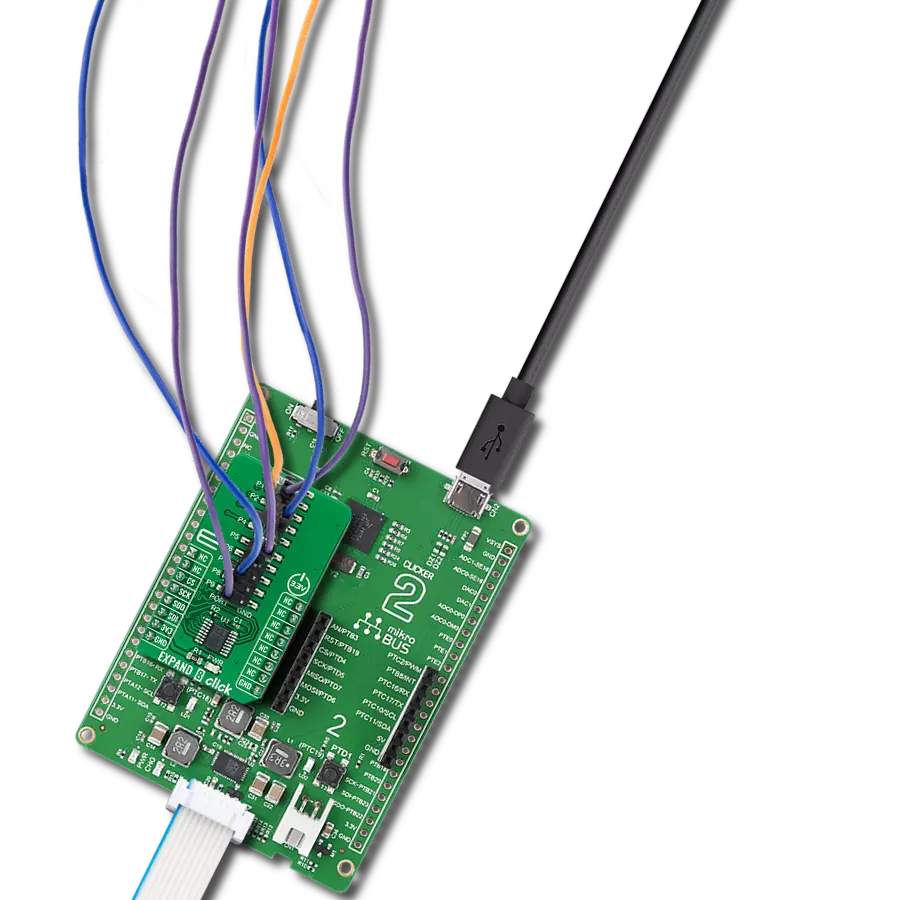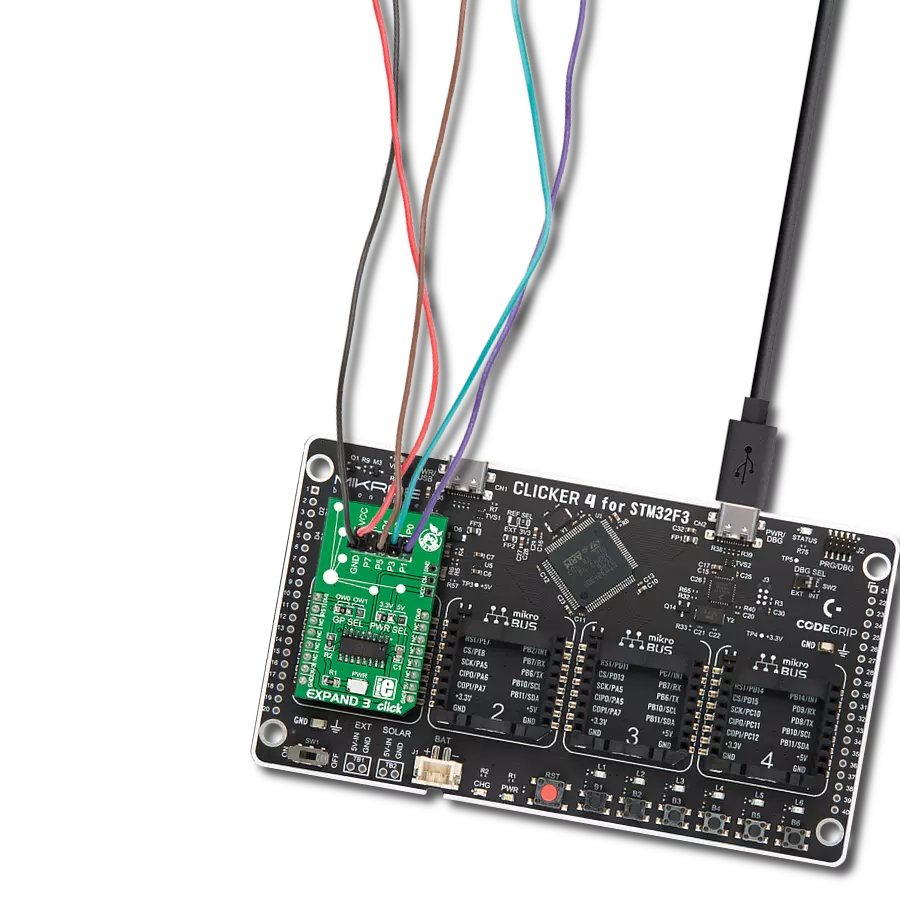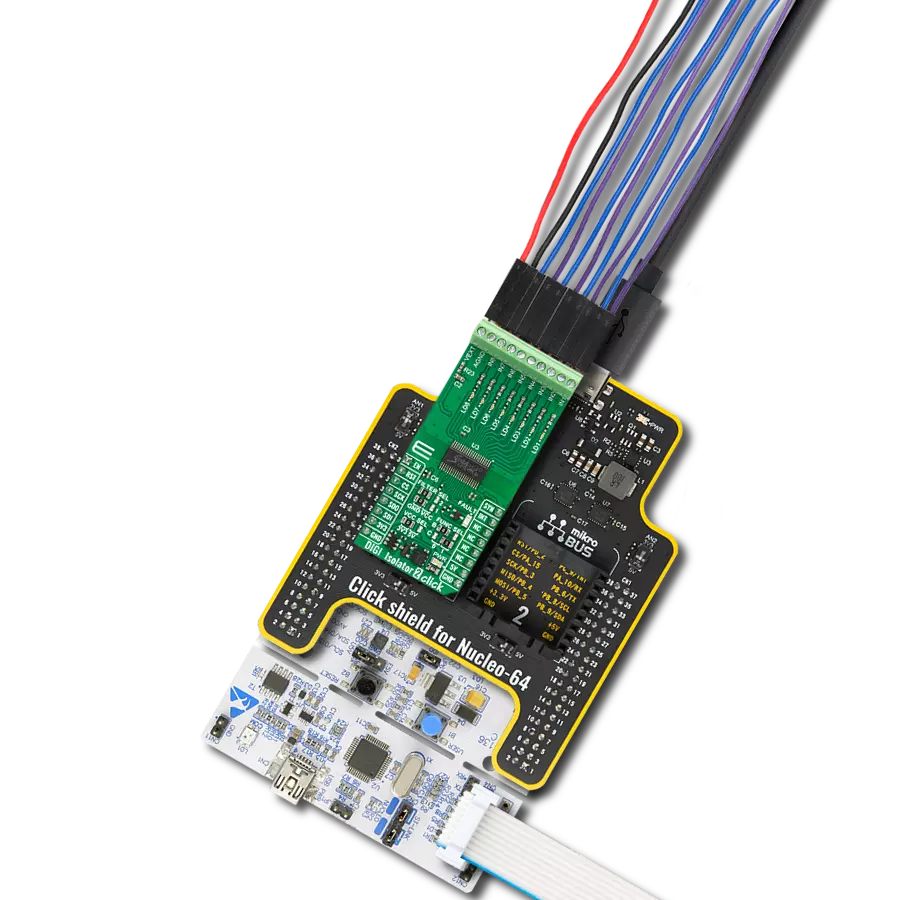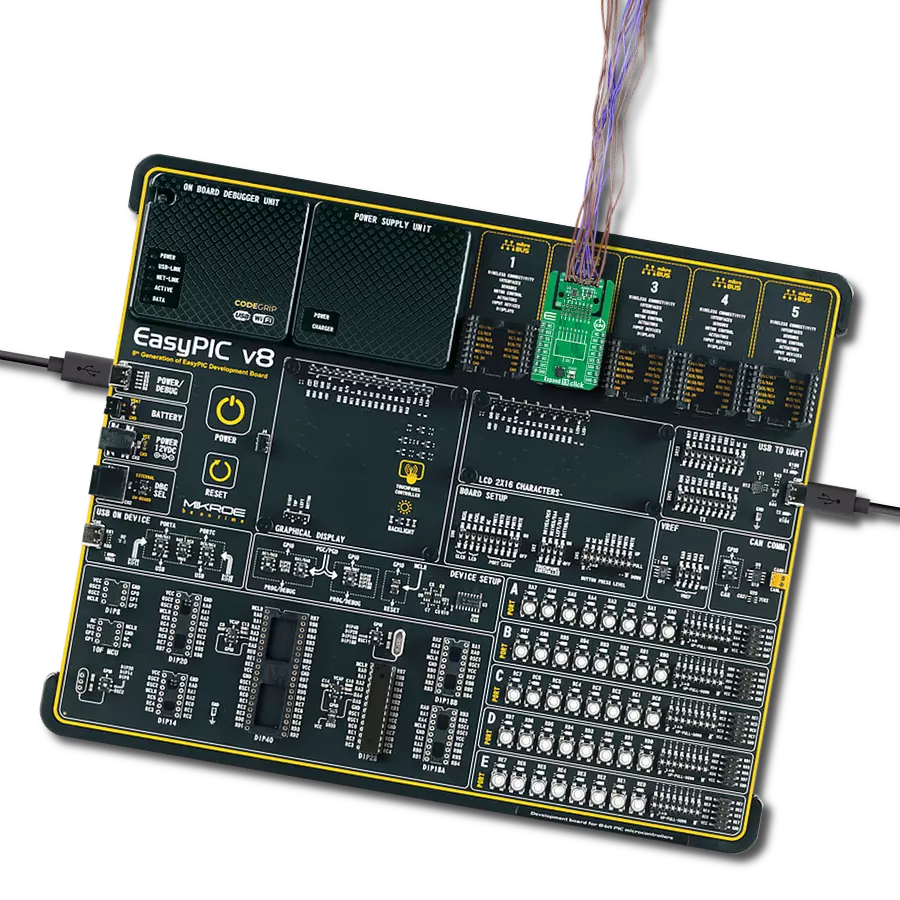Add more input and output pins to your project for increased functionality
A
A
Hardware Overview
How does it work?
Expand 17 Click is based on the TCAL6408, an 8-bit I/O expander from Texas Instruments designed to provide input/output expansion through the I2C protocol. This Click board™ offers an ideal solution for adding more I/Os to the system when dealing with switches, sensors, push-buttons, LEDs, fans, and other peripherals. The TCAL6408 IC features agile I/O configuration registers, providing programmable output drive strength, latchable inputs, maskable interrupts, programmable pull-up/down resistors, and the ability to configure open-drain or push-pull outputs. These advanced features ensure enhanced I/O performance with improved speed, power consumption, and reduced
electromagnetic interference (EMI). The TCAL6408 supports independent logic and power supplies. The logic voltage is supplied via the 3.3V mikroBUS™ power rail, while the main power can be selected between 3.3V from the mikroBUS™ or an externally provided supply through the VIN terminal, with a range of 1.08V to 3.6V. The main power selection is managed by the VCCP SEL jumper, allowing users to set the appropriate power source for the TCAL6408 based on their application's requirements. Expand 17 Click communicates with the host MCU via the standard 2-wire I2C interface, supporting clock frequencies up to 1MHz. The I2C address is easily configurable
using the onboard ADDR SEL jumper. Additionally, this board also uses an active-low reset (RST) pin, used for initializing the device, and an open-drain active-low interrupt (INT) pin, which provides notification of changes in input status, ensuring efficient handling of external events and inputs. This Click board™ can be operated only with a 3.3V logic voltage level. The board must perform appropriate logic voltage level conversion before using MCUs with different logic levels. Also, it comes equipped with a library containing functions and an example code that can be used as a reference for further development.
Features overview
Development board
Clicker 2 for Kinetis is a compact starter development board that brings the flexibility of add-on Click boards™ to your favorite microcontroller, making it a perfect starter kit for implementing your ideas. It comes with an onboard 32-bit ARM Cortex-M4F microcontroller, the MK64FN1M0VDC12 from NXP Semiconductors, two mikroBUS™ sockets for Click board™ connectivity, a USB connector, LED indicators, buttons, a JTAG programmer connector, and two 26-pin headers for interfacing with external electronics. Its compact design with clear and easily recognizable silkscreen markings allows you to build gadgets with unique functionalities and
features quickly. Each part of the Clicker 2 for Kinetis development kit contains the components necessary for the most efficient operation of the same board. In addition to the possibility of choosing the Clicker 2 for Kinetis programming method, using a USB HID mikroBootloader or an external mikroProg connector for Kinetis programmer, the Clicker 2 board also includes a clean and regulated power supply module for the development kit. It provides two ways of board-powering; through the USB Micro-B cable, where onboard voltage regulators provide the appropriate voltage levels to each component on the board, or
using a Li-Polymer battery via an onboard battery connector. All communication methods that mikroBUS™ itself supports are on this board, including the well-established mikroBUS™ socket, reset button, and several user-configurable buttons and LED indicators. Clicker 2 for Kinetis is an integral part of the Mikroe ecosystem, allowing you to create a new application in minutes. Natively supported by Mikroe software tools, it covers many aspects of prototyping thanks to a considerable number of different Click boards™ (over a thousand boards), the number of which is growing every day.
Microcontroller Overview
MCU Card / MCU

Architecture
ARM Cortex-M4
MCU Memory (KB)
1024
Silicon Vendor
NXP
Pin count
121
RAM (Bytes)
262144
Used MCU Pins
mikroBUS™ mapper
Take a closer look
Click board™ Schematic
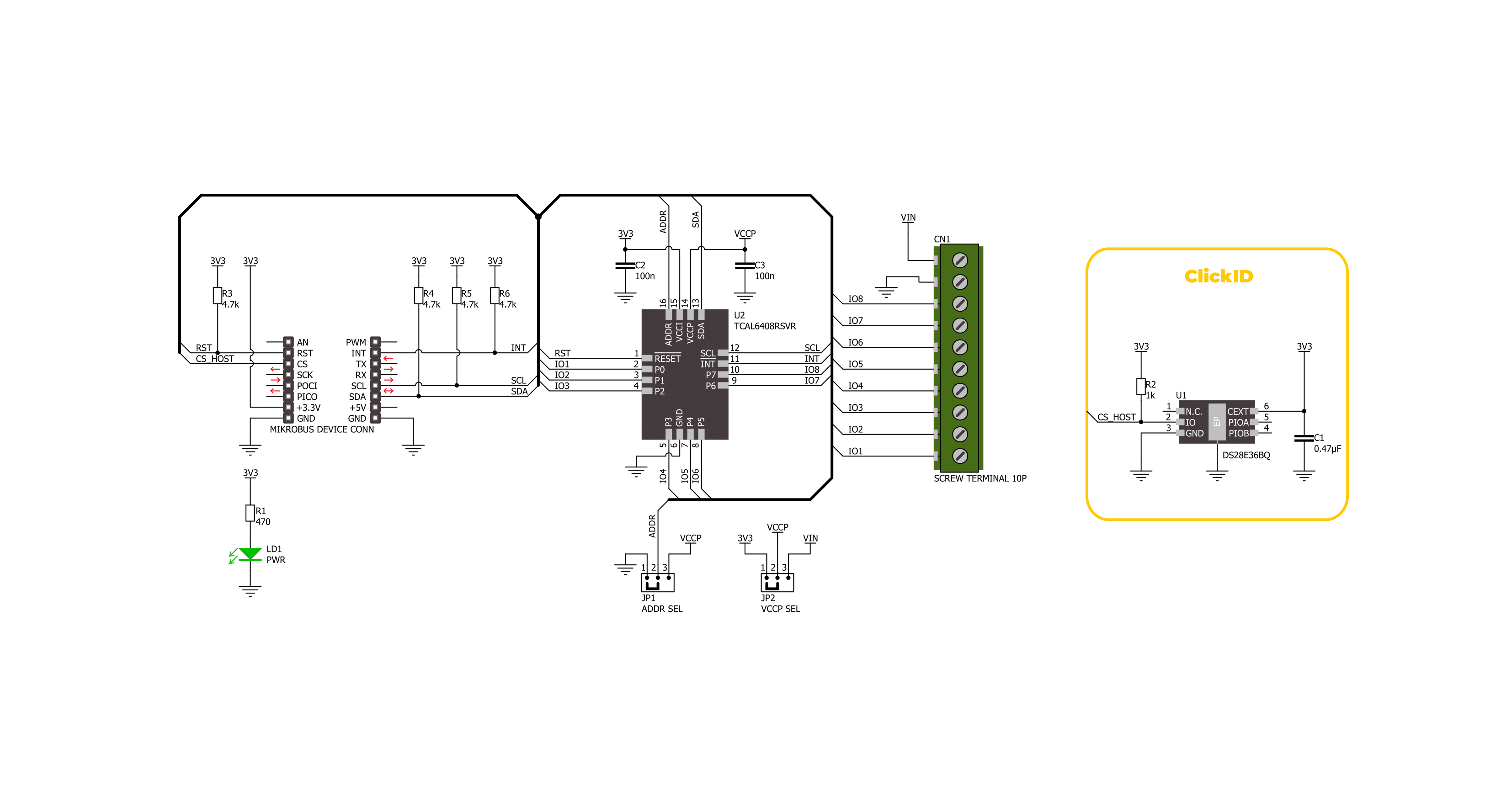
Step by step
Project assembly
Software Support
Library Description
This library contains API for Expand 17 Click driver.
Key functions:
expand17_set_io_dir- This function is used to set input or output direction of pins.expand17_set_output_state- This function is used to set output state of the pins.expand17_get_input_state- This function is used to get state of the input pins.
Open Source
Code example
The complete application code and a ready-to-use project are available through the NECTO Studio Package Manager for direct installation in the NECTO Studio. The application code can also be found on the MIKROE GitHub account.
/*!
* @file main.c
* @brief Expand 17 Click example
*
* # Description
* This example demonstrates the use of Expand 17 Click board by setting and reading
* the ports state.
*
* The demo application is composed of two sections :
*
* ## Application Init
* Initializes the driver and performs the Click default configuration which sets
* half of pins as output ( IO5, IO6, IO7 and IO8 ) and the
* half of the pins as inputs ( IO1, IO2, IO3 and IO4 ).
*
* ## Application Task
* Sets the state of the output pins and then reads the status of the input pins
* and displays the results on the USB UART approximately every 2 seconds.
*
* @note
* In order for this example to work as intended it is necessary to connect the input and output pins
* eg. IO1 and IO5, IO2 and IO6 etc. Floating input pins will be shown as a high state.
*
* @author Stefan Ilic
*
*/
#include "board.h"
#include "log.h"
#include "expand17.h"
static expand17_t expand17;
static log_t logger;
void application_init ( void )
{
log_cfg_t log_cfg; /**< Logger config object. */
expand17_cfg_t expand17_cfg; /**< Click config object. */
/**
* Logger initialization.
* Default baud rate: 115200
* Default log level: LOG_LEVEL_DEBUG
* @note If USB_UART_RX and USB_UART_TX
* are defined as HAL_PIN_NC, you will
* need to define them manually for log to work.
* See @b LOG_MAP_USB_UART macro definition for detailed explanation.
*/
LOG_MAP_USB_UART( log_cfg );
log_init( &logger, &log_cfg );
log_info( &logger, " Application Init " );
// Click initialization.
expand17_cfg_setup( &expand17_cfg );
EXPAND17_MAP_MIKROBUS( expand17_cfg, MIKROBUS_1 );
if ( I2C_MASTER_ERROR == expand17_init( &expand17, &expand17_cfg ) )
{
log_error( &logger, " Communication init." );
for ( ; ; );
}
if ( EXPAND17_ERROR == expand17_default_cfg ( &expand17 ) )
{
log_error( &logger, " Default configuration." );
for ( ; ; );
}
log_info( &logger, " Application Task " );
}
void application_task ( void )
{
uint8_t input_state = 0;
log_printf( &logger, " Setting output pins state: HIGH \r\n" );
log_printf( &logger, " = = = = = = = = = = = = = = = = = \r\n" );
expand17_set_output_state( &expand17, EXPAND17_NO_IO_PIN_MASK, EXPAND17_IO_5_PIN_MASK |
EXPAND17_IO_6_PIN_MASK | EXPAND17_IO_7_PIN_MASK |
EXPAND17_IO_8_PIN_MASK );
log_printf( &logger, " State of input pins: \r\n" );
log_printf( &logger, " = = = = = = = = = = = = = = = = = \r\n" );
expand17_get_input_state( &expand17, &input_state );
if ( input_state & EXPAND17_IO_1_PIN_MASK )
{
log_printf( &logger, " IO1 - HIGH \r\n" );
}
else
{
log_printf( &logger, " IO1 - LOW \r\n" );
}
if ( input_state & EXPAND17_IO_2_PIN_MASK )
{
log_printf( &logger, " IO2 - HIGH \r\n" );
}
else
{
log_printf( &logger, " IO2 - LOW \r\n" );
}
if ( input_state & EXPAND17_IO_3_PIN_MASK )
{
log_printf( &logger, " IO3 - HIGH \r\n" );
}
else
{
log_printf( &logger, " IO3 - LOW \r\n" );
}
if ( input_state & EXPAND17_IO_4_PIN_MASK )
{
log_printf( &logger, " IO4 - HIGH \r\n" );
}
else
{
log_printf( &logger, " IO4 - LOW \r\n" );
}
log_printf( &logger, " = = = = = = = = = = = = = = = = = \r\n" );
Delay_ms ( 1000 );
Delay_ms ( 1000 );
log_printf( &logger, " Setting output pins state: LOW \r\n" );
log_printf( &logger, " = = = = = = = = = = = = = = = = = \r\n" );
expand17_set_output_state( &expand17, EXPAND17_IO_5_PIN_MASK | EXPAND17_IO_6_PIN_MASK |
EXPAND17_IO_7_PIN_MASK | EXPAND17_IO_8_PIN_MASK,
EXPAND17_NO_IO_PIN_MASK );
log_printf( &logger, " State of input pins: \r\n" );
log_printf( &logger, " = = = = = = = = = = = = = = = = = \r\n" );
expand17_get_input_state( &expand17, &input_state );
if ( input_state & EXPAND17_IO_1_PIN_MASK )
{
log_printf( &logger, " IO1 - HIGH \r\n" );
}
else
{
log_printf( &logger, " IO1 - LOW \r\n" );
}
if ( input_state & EXPAND17_IO_2_PIN_MASK )
{
log_printf( &logger, " IO2 - HIGH \r\n" );
}
else
{
log_printf( &logger, " IO2 - LOW \r\n" );
}
if ( input_state & EXPAND17_IO_3_PIN_MASK )
{
log_printf( &logger, " IO3 - HIGH \r\n" );
}
else
{
log_printf( &logger, " IO3 - LOW \r\n" );
}
if ( input_state & EXPAND17_IO_4_PIN_MASK )
{
log_printf( &logger, " IO4 - HIGH \r\n" );
}
else
{
log_printf( &logger, " IO4 - LOW \r\n" );
}
log_printf( &logger, " = = = = = = = = = = = = = = = = = \r\n" );
Delay_ms ( 1000 );
Delay_ms ( 1000 );
}
int main ( void )
{
/* Do not remove this line or clock might not be set correctly. */
#ifdef PREINIT_SUPPORTED
preinit();
#endif
application_init( );
for ( ; ; )
{
application_task( );
}
return 0;
}
// ------------------------------------------------------------------------ END
Additional Support
Resources
Category:Port expander


















